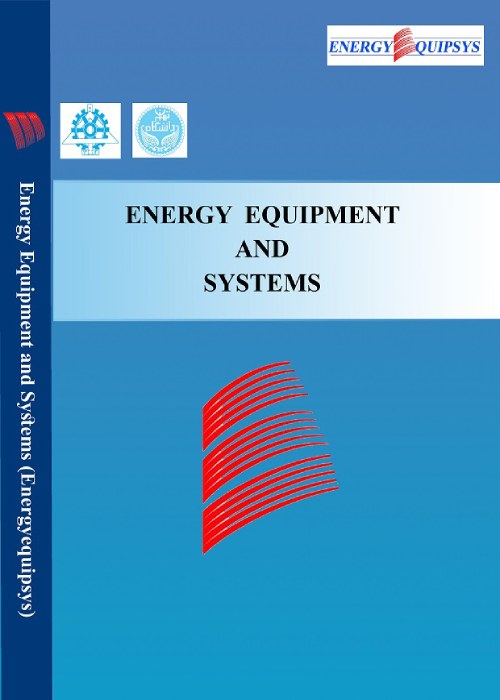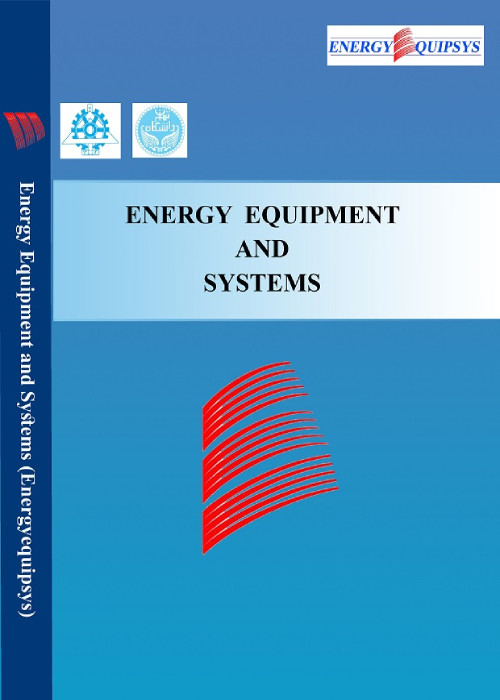فهرست مطالب

Energy Equipment and Systems
Volume:10 Issue: 4, Autumn 2022
- تاریخ انتشار: 1401/11/18
- تعداد عناوین: 7
-
-
Pages 327-352In the present work, heat transfer and entropy generation due to the natural convection of Newtonian and non-Newtonian fluids in two types of shear thinning and shear thickening inside a right-triangular cavity under the effect of uniform and non-uniform magnetic field by multiple relaxation time lattice Boltzmann methods have been investigated. The aspect ratio of the cavity is variable and the magnetic field is applied from left to right and perpendicular to the gravity of the cavity. The present work is validated with previous references and results presented in the form of tables, diagrams and streamlines, isothermal lines, and entropy lines. The simulation is done by writing the computer code in the Fortran language. The effect of Rayleigh number, aspect ratio, power-law index of fluid, Hartmann number and angle, and type of magnetic field applied on fluid flow and heat transfer characteristics has been evaluated. The results show that in all cases, increasing the Hartmann number and fluid power-law index leads to a decrease in the strength of flow, heat transfer rate, and entropy generated and the percentage of this effect varies depending on the number of other variables. By applying a magnetic field non-uniformly, the flow strength and heat transfer rate can be increased to about 45% and 20%, respectively. At higher Hartmann numbers, the effect of changing the type of magnetic field applied is more pronounced. The angle of the magnetic field applied is a determinant parameter on the amount of heat transfer so that the average Nusselt number in the horizontal mode is on average 15% less than in the vertical mode. Increasing of power-law index dramatically reduces the magnetic field effect so that it is ineffective for the shear thickening fluid, the type of magnetic field applied. By increasing the Rayleigh number and the aspect ratio of the cavity, the flow strength and the rate of heat transfer increase and the effect of the magnetic field becomes more pronounced. This study can be useful in the optimal design of industrial and engineering equipment, including electronic coolers.Keywords: Natural convection, Power-law Fluids, Non-uniform magnetic field, Entropy generation, Variable Aspect Ratio, Triangular Cavity, MRT-LBM
-
Pages 353-374
The main contribution of this study is to highlight the position effect of the absorber plate as a passive heat transfer enhancement technique on the ventilation and thermal performance of a solar air heater, including outlet air temperature, airflow rate, and thermal efficiency. The turbulent free convection heat transfer in a vertical flat-plate solar air heater with single and double passes is numerically studied. A total of four cases of airflow (three double-pass and one single-pass air heater) are simulated and compared. The set of transient governing equations, including the continuity, momentum, and energy are solved to simulate the turbulent free convection airflow inside the heater based on the turbulence model, while the transient conduction equation is solved inside the solid elements, i.e., bottom plat, absorber, and glass cover based on the finite-element method. The results reveal that the position of the absorber plate has a double-edged sword impact on the performance of solar air heaters, including the airflow rate and outlet air temperature. Moreover, a 100% increase in the natural air flow rate is observed for the double-pass heater compared to the single-pass one. Moreover, a 15% improvement in thermal efficiency can be obtained from 68% to 78% in the double-pass solar air heater based on the position of the absorber plate. Based on the criteria, including the outlet temperature, airflow rate, or thermal efficiency, the presented results can be used as a good reference to choose an alternative for solar air heaters.
Keywords: Double-Pass Solar Air Heater, Natural Turbulent Convection, Space Heating, Heat transfer enhancement, Absorber Plate -
Pages 375-388Iran's energy sector, which includes power generation, transportation, industry, buildings, and homes, is a significant source of greenhouse gas emissions. Plans for efficient design and development of maximum power control systems aim to increase the share of renewable energy in electricity usage. Floating photovoltaic systems combine existing photovoltaic systems with a floating structure to generate clean energy and integrate existing dams to enhance power sources. The results indicate that installing a hybrid floating solar power plant at a level of more than 1 km2 over the dam reservoir's surface provides 194 GWh to 257 GWh of electricity per year. Installation floating photovoltaic plant would supply electricity for 2260 green cottages while also improving the environment and reducing water evaporation. Adding a floating solar power plant with 10% of the lake reservoir cover of six dams saves 70.7 million cubic meters of water per year which is enough to meet the annual needs of one million people. This study fills a research gap in the energy sector by studying the economics of hybrid renewable energy systems in Net-zero energy buildings.Keywords: Renewable Energy, Electricity, Floating Photovoltaic, Green Cottages, Net-Zero Energy Buildings
-
Pages 389-399
Airfoil self-noise is one of the dominant sources of airframe noises which causes limitations in many applications such as wind turbines. This paper investigates and quantifies the sensitivity of airfoil self-noise prediction to the grid resolution using large eddy simulation. Three-dimensional incompressible fluid flow around a NACA0012 airfoil at zero angle of attack with a chord-based Reynolds number of 6.4×105 is numerically analyzed in this paper. Far-field noise is predicted by Ffowcs-Williams & Hawkings model using the results of large eddy simulation. Three different grid sizes are used to investigate the effect of grid resolution on the accuracy of self-noise prediction. Results are compared with the experimental data of wind tunnel tests and noise measurements with microphones. Although the aerodynamic properties are calculated accurately in all grids, the grid resolution over the surface has a significant effect on the accuracy of the noise prediction. This effect of grid resolution is quantified in this paper. By the increase of grid points in the spanwise and streamwise directions on the surface, numerical noise prediction has approached the experimental data. The difference with the experimental data decreases from 20 dB to 3 dB in some frequencies. In addition, having doubled the number of surface grid points in both directions the average percentage of difference with the experimental data decreases from 5% to 2%.
Keywords: Large-Eddy Simulation, Grid Resolution, Aeroacoustics, Self-Noise -
Pages 401-415
In this paper, the induced airflow and the resultant resuspension of particles due to human walking are studied numerically using the dynamic mesh technique. Based on the results, the air is ejected from the sole and floor gap when the foot moves down, similar to a radial wall jet. During the upward motion, a strong gap flow is induced beneath the sole, which causes the surrounding air to be sucked toward the shoe center. Accordingly, particles are mainly detached in the downward motion of the foot. Then, they are entrained into the far-field flow during the foot's upward motion. Simulations indicate that the region beneath the sole edges is the most susceptible area for particles to be detached. As a result, fast walking is associated with a higher resuspension rate per footstep, up to two orders of magnitude due to increased shear stress on the floor. Although the shoe size influences the rate of particle resuspension, it is not as significant as the stepping time. Based on the results, the shear velocity due to stepping may be up to 0.4 m/s which can resuspend 10 μm particles with a resuspension rate of about 10-5 s-1. The effect of the main geometric features of the stepping process, including the stepping time and the shoe size, are investigated to provide a general correlation for its prediction with the R-squared value of 0.99.
Keywords: Particles Resuspension, walking, Computational fluid dynamics, Dynamic mesh -
Pages 417-437
In this research, a new trigeneration system with the prime mover of solid oxide fuel cells and solar energy was simulated to supply the required energy of a sample building in Shahrood, Iran. For this purpose, at first, the required loads of the building have been calculated. Then, the trigeneration system was used to provide the required heating, cooling, and electrical loads for the building. The analysis was performed for each component of the system from energy aspects. Then the obtained equations were solved using EES software. The results showed that the total amount of electrical power produced by the system in spring and summer is about 1184.5 kW and in autumn and winter is 1121.7 kW. The total electrical energy produced by the system during the year is about 9921112 kWh. Also, 1301.2 MWh of thermal energy was collected by 50 solar panels throughout the year. The electrical efficiency of the fuel cell is 46.77% and the whole system is 53.97%. Also, the thermal efficiency of the whole system is equal to 86.9%. The carbon dioxide emission coefficient is 358.2, which is very low and desirable compared to fossil fuel systems. Due to the intensity of solar radiation in the city of Shahrood, the designed system can provide heat and cold loads for the building well and the efficiency of the trigeneration system is much higher than similar systems and the amount of pollution is much lower.
Keywords: Trigeneration, Solid oxide fuel cell, Solar Energy, Energy Analysis, Environmental analysis -
Pages 439-457
A new unified system that runs with solid oxide fuel cells (SOFC) is proposed. Thermodynamic laws have been used to describe and analyze system performance. For this purpose, the reported system is simulated by the EES (Engineering Equations Solver) software. The calculations of this study show that the introduced hybrid system generates net electricity, and distilled water of 460.3 kW, and 307.368 kg/h, correspondingly. Also, the total energy and exergy efficiencies for the whole system are obtained as 81.87 and 55.26, respectively. It was also found that increasing the pressure and using the gas turbine in the fuel cell cycle would increase the SOFC energy and exergy efficiency from values 53.88 and 51.97 to energy and exergy electrical efficiency values of 56.76 and 54.75. Additionally, the heater, afterburner, and SOFC stack are recognized as the utmost destructive constituents by 61.22, 58.75 kW and 5.46 kW, correspondingly. Also, the influence of influential factors on system performance including solid oxide fuel cell current density and its inlet temperature, high desalination temperature, humidifier effectiveness, compression ratio, dehumidifier effectiveness and desalination flow ratio has been studied.
Keywords: Hybrid System, SOFC, HDH System, Thermodynamic, Energetic, Exergetic


